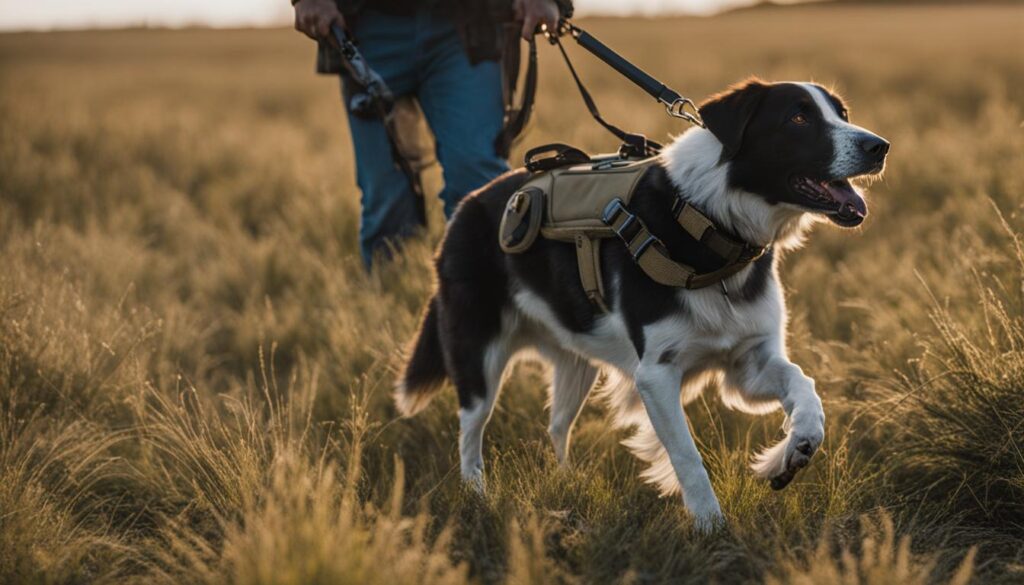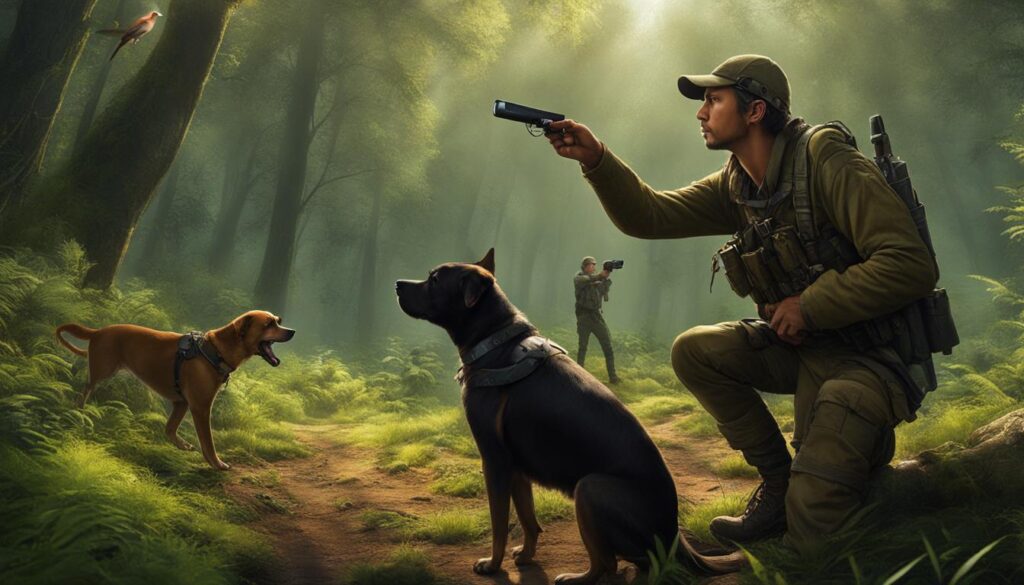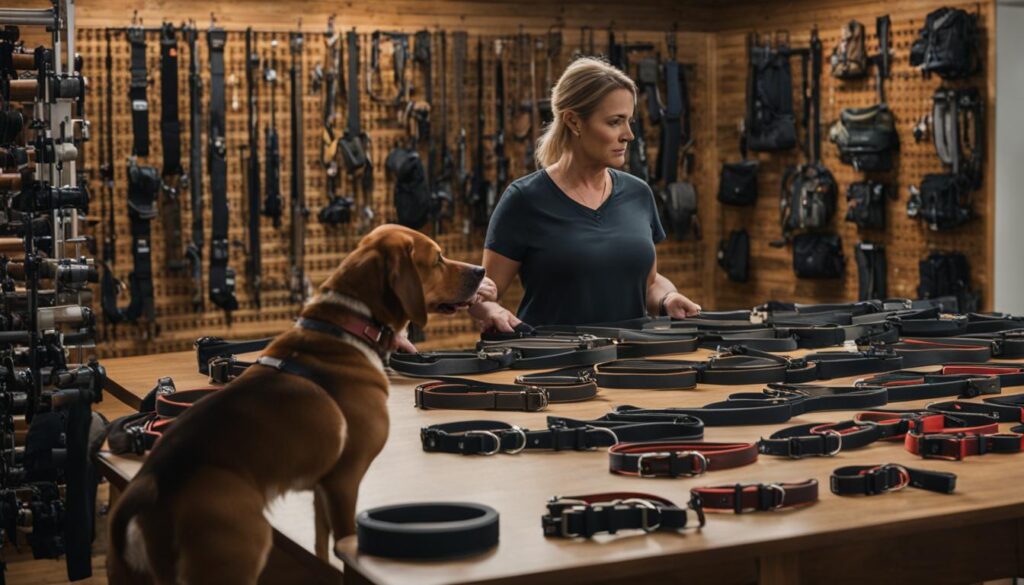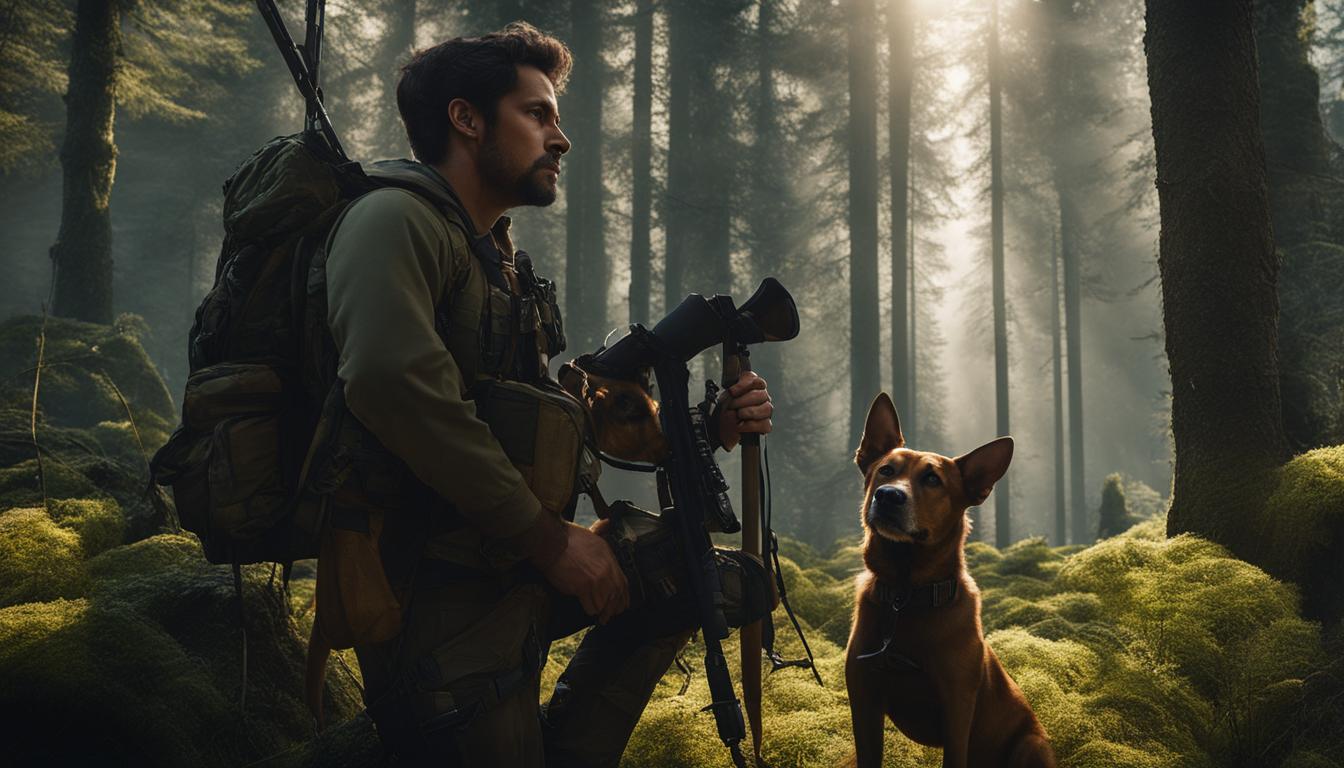Training hunting dogs can be a challenging yet rewarding experience. Utilizing a hunting dog shock collar or shock collar for hunting dogs can make the process more efficient and successful. This guide will provide insights on How To Use Shock Collar For Hunting Training and hunting e-collar options, ensuring your dog becomes a disciplined and reliable hunting partner.
Training hunting dogs requires a combination of patience, skill, and the right tools. A shock collar, also known as an e-collar or remote training collar, can be an effective tool to reinforce obedience and correct undesirable behaviors during hunting training sessions. Designed to deliver adjustable electronic stimulation, shock collars provide trainers with the ability to communicate with their dogs from a distance, ensuring safety and control in the field.
In this comprehensive guide, I will walk you through the process of effectively using a shock collar for hunting training. From understanding the role and importance of shock collars to step-by-step training techniques and selecting the right collar for your hunting dog, you will gain the knowledge and confidence to train your four-legged companion into a skilled and obedient hunting partner.
Key Takeaways:
- Training hunting dogs with shock collars can make the process more efficient and successful.
- A shock collar is an electronic training tool that delivers adjustable stimulation to reinforce obedience and correct behaviors.
- Using a shock collar requires understanding its functions, proper timing, and intensity of corrections.
- Positive reinforcement should be incorporated alongside the use of the shock collar to create a balanced training approach.
- By following proper training methods, hunting dogs can be successfully trained using a shock collar.
The Importance of Using Shock Collar in Hunting Training
Understanding the role of hunting dog shock collars is crucial in comprehending the importance of using them in hunting training. These collars act as a tool to correct undesired behavior and reinforce obedience in the field. With adjustable intensity, trainers can customize the training experience to suit the individual needs of their hunting dogs. The benefits of using e-collars in hunting include improved obedience, increased safety, and enhanced control over hunting dogs during fieldwork.
Understanding the Role of Hunting Dog Shock Collars
Hunting dog shock collars play a significant role in training and disciplining hunting dogs. They provide a means of communication between the trainer and the dog, allowing for timely correction of unwanted behavior. By delivering mild electric stimulation, these collars can discourage behaviors such as excessive barking, chasing wildlife, or straying too far from the trainer. The instant feedback provided by the shock collar helps the dog associate the correction with the specific behavior, promoting faster learning and improved obedience.
Adjustable Intensity for Effective Training
The adjustable intensity feature of shock collars allows trainers to tailor the training experience to the specific needs and temperament of their hunting dogs. Different dogs may respond differently to varying levels of stimulation, and adjustable intensity ensures that the training remains effective without causing unnecessary discomfort or stress. Trainers can start with a lower intensity and gradually increase it as the dog progresses in its training, ensuring a humane and successful learning process.
Benefits of Using E-Collars for Obedience in the Field
Using e-collars for obedience training in the field offers a range of benefits for both the trainer and the dog. Firstly, it enhances obedience, enabling hunting dogs to follow commands even in challenging environments or distracting situations. This level of control ensures a safer and more efficient hunting experience. Secondly, e-collars improve safety by providing a way to recall a dog quickly, preventing potential dangers or conflicts with wildlife. Lastly, e-collars allow trainers to maintain a close bond and effective communication with their hunting dogs, fostering a strong and reliable partnership.
How to Use Shock Collar for Hunting Training


Using a shock collar for hunting training requires proper techniques and guidelines to ensure effective and humane training. As a trainer, it is essential to familiarize yourself with the functions of the shock collar and understand the correct timing and intensity of corrections.
When using a shock collar for hunting training, it is important to incorporate positive reinforcement alongside the collar's usage. Motivating and rewarding your hunting dog for desired behaviors can enhance their training experience and strengthen the bond between you and your four-legged companion.
For successful training with a shock collar, consider the following guidelines:
- Familiarize yourself with the shock collar: Take the time to understand the features and functions of the shock collar you are using. Read the manufacturer's instructions and educate yourself on the various settings and modes available.
- Timing is crucial: Corrections delivered through the shock collar should be properly timed to ensure they are associated with the undesired behavior. It is important to correct your dog immediately after they exhibit the undesired behavior, as this will help them make the connection between the correction and their actions.
- Gradually increase intensity: Start with low-intensity corrections and gradually increase the level only if necessary. It is essential to find the right balance between effective training and the well-being of your hunting dog. Consulting a professional trainer can help guide you in determining the appropriate intensity for your dog.
- Use positive reinforcement: Alongside the use of the shock collar, incorporate positive reinforcement techniques such as treats, praise, and playtime. This will reinforce desired behaviors and motivate your hunting dog to perform obediently in the field.
- Consistency is key: Maintain a consistent training routine and ensure that all members of your hunting party follow the same training guidelines. This will prevent confusion and reinforce the learned behaviors across different environments.
By following these proper training methods, you can effectively train your hunting dog using a shock collar while prioritizing their well-being and maintaining a strong and trusting bond. Remember, a well-trained hunting dog is a disciplined and reliable partner in the field.
Step-by-Step Guide to Training with E-Collars


Training hunting dogs with e-collars is a systematic process that involves several steps. This step-by-step guide will outline the key stages of training, starting with basic obedience and progressing to advanced techniques for specialized hunting skills. By following these steps, trainers can develop disciplined and reliable hunting partners.
Starting with Basic Obedience Training
Before incorporating e-collars into the training process, it is essential to establish a strong foundation in basic obedience. This involves teaching the hunting dog essential commands such as sit, stay, come, and heel. Basic obedience training helps build a common language between the trainer and the dog, ensuring effective communication and control.
During this stage, trainers should focus on positive reinforcement techniques, rewarding the dog for correct behaviors and using treats or praise to motivate the dog. Consistency and repetition are key in reinforcing basic obedience commands, helping the dog understand and comply with instructions reliably.
Incorporating Shock Collar Training Techniques
Once the hunting dog has a solid grasp of basic obedience commands, it is time to introduce the e-collar into the training process. E-collars provide a way to enforce commands and correct unwanted behaviors through mild electronic stimulation.
When using shock collar training techniques, it is crucial to start with low-intensity settings to ensure the dog's comfort and safety. Trainers should gradually increase the intensity only when necessary, focusing on capturing the dog's attention and reinforcing obedience. Positive reinforcement should still be incorporated alongside the use of the shock collar, helping the dog understand the desired behaviors and avoid unwanted actions.
Consistency and timing are critical when utilizing shock collar training techniques. Trainers should ensure that corrections are delivered immediately after the undesired behavior occurs, allowing the dog to associate the correction with the specific action. With practice and repetition, the hunting dog will learn to respond to commands and understand the consequences of disobedience.
Advanced Training for Specialized Hunting Skills
Once the hunting dog has mastered basic obedience and is comfortable with the shock collar, trainers can progress to advanced training for specialized hunting skills. This stage involves introducing more complex tasks and scenarios to simulate real hunting situations.
During advanced training, trainers can focus on specific hunting skills such as retrieving, scent detection, tracking, or pointing, depending on the hunting dog's breed and abilities. The shock collar can be used to reinforce commands and correct behaviors related to these specialized tasks, ensuring the dog performs optimally in the field.
It is important to note that advanced training should always be approached gradually and with patience. Trainers should provide ample time for the dog to understand and master each skill before moving on to the next level of complexity. By gradually increasing the difficulty of training exercises, trainers can develop a well-rounded hunting dog with specialized hunting skills.
Overall, training hunting dogs with e-collars requires a step-by-step approach, starting with basic obedience training and gradually progressing to advanced techniques for specialized hunting skills. Through consistent and positive reinforcement, along with the appropriate use of the shock collar, trainers can develop disciplined and reliable hunting partners.
Selecting the Right Shock Collar for Your Hunting Dog


When it comes to training your hunting dog, selecting the right shock collar is paramount. By choosing a collar that meets your dog's needs and your training goals, you can optimize the training experience and ensure successful outcomes. Here are some key factors to consider when selecting a shock collar for your hunting dog.
Features of High-Quality Shock Collars
A high-quality shock collar should possess certain features that contribute to effective training. Adjustable intensity levels are essential, as they allow you to customize the stimulation to suit your dog's specific needs and sensitivity. Additionally, durable construction is important for withstanding the rigors of outdoor use. Look for shock collars made from sturdy materials that can withstand water, dirt, and rough handling. Another feature to consider is sufficient range, which allows you to maintain control over your hunting dog even at a distance.
Considerations When Choosing a Collar Size and Range
When selecting a shock collar for your hunting dog, collar size and range are important considerations. The collar should fit comfortably and securely on your dog's neck without causing any discomfort or restricting movement. Measure your dog's neck and choose a collar size accordingly. Additionally, consider the range of the shock collar. Depending on your hunting needs, you may require a collar with a longer range to ensure effective communication and control in various hunting scenarios.
Modern Technologies in E-Collar Training
E-collar training has evolved significantly in recent years, thanks to modern technologies. Look for shock collars that incorporate advanced features such as GPS tracking, remote control functionality, and compatibility with smartphone apps. These technologies can enhance the training experience by providing real-time tracking and data analysis, allowing you to monitor your dog's progress and make informed training decisions.
Conclusion
Successful hunting training with shock collars requires a harmonious blend of patience and technology. As a trainer, I understand the importance of approaching the training process with patience, recognizing that it takes time to mold hunting dogs into disciplined and reliable partners. By being patient, we allow our dogs to learn at their own pace, helping them develop the necessary skills and behaviors for successful hunting.
Equally important is ensuring the safety and well-being of our hunting dogs throughout their training journey. It is crucial that we prioritize humane and ethical training practices, treating our dogs with respect and kindness. By using shock collars responsibly, we can guide our dogs without causing harm or distress. This involves setting appropriate intensity levels, using positive reinforcement techniques, and paying close attention to our dogs' reactions and well-being.
When we combine patience with technology, we have the power to unlock the full potential of our hunting dogs. Shock collars provide us with a valuable tool to reinforce obedience and control in the field, allowing for a more enjoyable and successful hunting experience. By utilizing this technology responsibly and with patience, we can transform our dogs into skilled hunting partners that we can rely on during our expeditions.
FAQ
What is the role of hunting dog shock collars in training?
Hunting dog shock collars acts as a tool to correct undesired behavior and reinforce obedience in the field.
How adjustable is the intensity of shock collars for hunting dogs?
Shock collars for hunting dogs have adjustable intensity levels, allowing trainers to customize the training experience to suit individual needs.
What are the benefits of using shock collars in hunting training?
The benefits of using shock collars in hunting training include improved obedience, increased safety, and enhanced control over hunting dogs during fieldwork.
How should I use a shock collar for hunting training?
Proper usage of a shock collar in hunting training involves familiarizing yourself with its functions, understanding correct timing and intensity of corrections, and incorporating positive reinforcement alongside the collar's use.
What is the step-by-step process for training hunting dogs with e-collars?
The step-by-step process includes starting with basic obedience training, incorporating the use of shock collars for reinforcement, and gradually introducing more complex hunting tasks.
How do I choose the right shock collar for my hunting dog?
When selecting a shock collar for your hunting dog, consider features such as adjustable intensity levels, collar size, range, and compatibility with modern training technologies.
How can I ensure safe and humane training practices when using shock collars?
It's important to prioritize the safety and well-being of hunting dogs by following humane and ethical training practices alongside the use of shock collars.
How can I combine patience and technology for successful hunting partners?
Successful hunting training with shock collars requires a combination of patience and technology. Trainers should approach the process patiently and understand that discipline takes time to establish.





